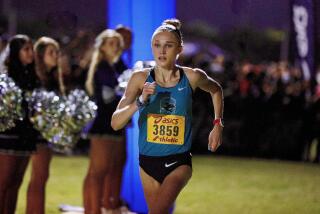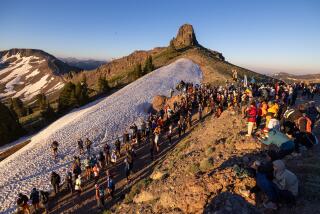Stepping Lively : After Stumbling Onto Racewalking, Newhall’s Herazo Now Holds Record
- Share via
By the age of 28, most people are beginning to give up competitive sports and get into activities like Scrabble, reading and lying in the hammock.
Victoria Herazo was headed in that direction. A self-described “terrible track athlete,” she anticipated a future of academic pursuits and maybe a little weekend jogging and tennis.
The last thing she expected was to become a competitive athlete. Let alone a world-class competitive track athlete.
But in a span of just 3 1/2 years, Herazo has made a swift ascent to the top echelon of the Olympic sport of racewalking. Last May, in The Athletics Congress national championships, Herazo--who didn’t even know what racewalking was until 1988--set a national record at 15 kilometers, clocking 1 hour 11 minutes 12.4 seconds. At the World Indoor championships in March, she was ninth in the 3,000 meters. Nobody is more astounded than Herazo.
“I’m very surprised I came as far as I did,” said Herazo, 32, of Newhall. “I guess I didn’t know I had any potential.”
A lean 6-foot-1, Herazo always has been a better athlete than she cared to admit--she put the shot 26 feet in high school in Cincinnati--but she never excelled in anything until racewalking came along. Like a golfer who picks up a club for the first time and executes a picture-perfect swing, Herazo quickly learned racewalking’s disciplined, synchronized technique.
“I’ve never seen anybody with such natural form,” said Jim Bentley, Herazo’s coach.
Herazo discovered Bentley and racewalking at the same time. Driving through Balboa Park, she saw a group of boys racewalking. Actually, she didn’t know what they were doing. They were jogging, sort of, while at the same time rolling their shoulders and twisting their hips as if they had a bug in their shorts. Herazo stopped her car and made an inquiry. She was pointed in the direction of the coach, Bentley.
“She kept saying to me: ‘Those kids walk faster than I can jog,’ ” Bentley recalled.
Bentley, the former chairman of the communications department at L.A. City College, had a special interest in racewalking. All four of his children, he says, have been national age-group record holders. In three weeks, he had Herazo racewalking fast enough to qualify for the 1988 Times Indoor Games. Three weeks later, she placed fifth in the mile there. The next year she was second. Last year she won it.
At first, racewalking “was a little awkward,” Herazo said. “But I tried to stay relaxed, go with the motion and not be jerky.”
Traveling the globe, mostly at her own expense, Herazo is having her best year in 1991 and has qualified for the World Championships on Aug. 24 in Tokyo. Her life has changed radically since that day in Balboa Park. Before, she was best known as the sister of TV actress Cristina Raines. Now, she has her own identity.
Racewalking fills a large void. She trains virtually every day, enters at least one race almost every weekend and appears to be constantly on the go.
“I won’t say I wasted my time before, but I didn’t concentrate it very well,” she said. “Now I lead a departmentalized life on a rigid schedule. But I’m the type of person who needs discipline. It helps me focus.”
And focus is what she does well. “Tori’s secret is that she can concentrate on short-term goals and then move on,” Bentley said. “She thrives on them.”
Bentley, who runs his own TV production company, videotapes Herazo’s races and workouts to critique her style and pick up errors. Much like a pacer in horse racing, racewalkers can be disqualified by judges for breaking stride. One foot must be in contact with the ground at all times and Bentley is always correcting minor flaws in Herazo’s technique.
“She gets lethargic at longer distances,” he said. “Her weakness lately is dropping her chin after about 25 laps and looking down.”
Every other day, Herazo walks seven or eight kilometers at race pace, the equivalent of a seven-minute mile. “She’s very devoted and always does what I tell her,” Bentley said, “but I have to be cautious not to have her do too much.”
In 1992, the Olympics will include women’s racewalking for the first time (the men long have had an event). Herazo, along with Debbie Lawrence, who beat Herazo in the 10K at the recent U.S. Olympic Festival, are strong candidates for the national team but longshots for a medal in Barcelona. The United States has won only one Olympic medal in men’s racewalking and traditionally ranks behind walkers from Eastern Europe and Mexico, where the sport is very popular.
“American women are far superior to American men in international competition,” Herazo said. She feels that “more kids should be exposed to racewalking,” but in reality, the sport is shrinking: Neither the NCAA nor NAIA hold championships in the event, and only one high school district, in New Jersey, still includes racewalking in meets, Bentley says.
To train for next spring’s Olympic Trials, Herazo will have to take about six months off work. With an Associate of Science degree from Pierce College, Herazo works as an animal health technician at the East Valley Animal Shelter in North Hollywood.
Single (“not many men would put up with my schedule”), Herazo hopes to someday find time to return to Cal State Northridge. She had been studying for a bachelor’s in biology, until she contracted the racewalking bug.
Now she’s taking things one step at a time.
More to Read
Go beyond the scoreboard
Get the latest on L.A.'s teams in the daily Sports Report newsletter.
You may occasionally receive promotional content from the Los Angeles Times.






